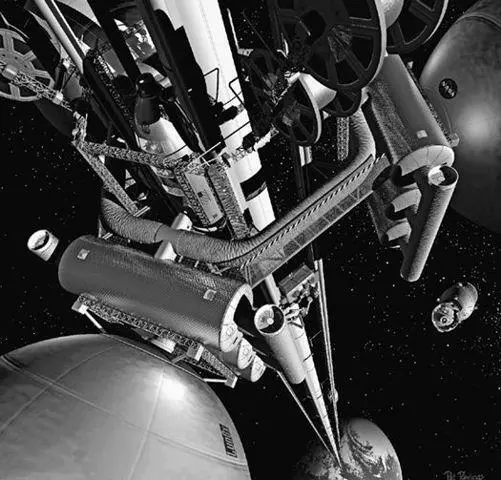A space elevator would be a permanent road into space, making it possible for people to make one or more trips per day into orbit. Passengers could bring materials up with them so that we could start building ships and habitats in space. Once we started mining and manufacturing in space, elevators would be used to bring payloads back down, too. Most important, a working space elevator is many thousands of times cheaper than the one-time-use Soyuz rockets that bring supplies to the International Space Station, only to destroy themselves in Earth’s atmosphere. NASA reports that each Space Shuttle launch cost about $450 million. Much of that money was spent on storing enough fuel to complete the round-trip back to Earth. But groups working on space-elevator plans believe their system could reduce the cost of transporting a pound of cargo into space from today’s $10,000 price tag to as little as $100 per pound.

In this illustration by Pat Rawlings for NASA, you can see the climber in the foreground and the tether stretching back down toward distant Earth. (illustration credit ill.19)
The elevator would be attached to the Earth at the equator, where geostationary orbit happens, probably on a floating platform off the coast of Ecuador in international waters. This is a likely building site because it is currently an area of ocean that experiences very little rough weather, and therefore the elevator could climb out of our atmosphere with as little turbulence as possible. According to Edwards’s plan, the elevator ribbon would stretch 100,000 kilometers out into space (about a quarter of the distance to the Moon), held taut by a counterweight that could be anything from a captured asteroid to a space station. A ride up would take several days, and along the ribbon would be way stations where people could get off and transfer to orbiting space stations or to vessels that would carry them to the Moon and beyond.
The elevator car itself is the easiest thing for us to build today. It would be an enormous container, with atmospheric controls for human cargo, connected to large robotic arms that would pull the car up the ribbon hand over hand. We already have robotic arms that can scale ropes and lift incredibly heavy objects. This aspect of the space elevator is so widely understood that the Space Elevator Conference sponsored a “kids’ day” that included LEGO space-elevator-climber races. Robots designed by teens and kids competed to see which could climb “ribbons” attached to the ceiling and place a “satellite” at the top.
Of course it will take some effort to get from LEGO climbers to lifters big enough to haul components of a space hotel up through thousands of kilometers of atmosphere and space. But this is within the capabilities of our current industrial technology. So we’ve got our elevator car. But how will it be powered?
One of the many arguments in favor of the elevator concept is that it will be environmentally sustainable. The dominant theory among would-be space-elevator engineers at this point is that we’ll install lasers on the space-elevator platform, aimed at a dish on the elevator that will capture the beam and convert it to power. This technology is also within our reach. In 2009, NASA awarded $900,000 to LaserMotive for its successful demonstration of this so-called “wireless power transmission” for space elevators. In 2012, NASA offered a similar prize for a power-beaming lunar rover. The biggest problem with the power-beaming idea currently is that we are still looking at fairly low-power lasers, and as the space elevator ascended higher into the atmosphere the beam from such a laser would scatter and be blocked by clouds. It’s possible that only 30 percent of the beam would reach the dish once the elevator was in space.
Still, we have seen successful demonstrations of power beaming, and companies are working on refining the technology. We don’t quite have our perfect power beam yet, but it’s on the way.
The Missing Piece: An Elevator Cable
At the Space Elevator Conference, participants devoted an entire day to technical discussions about how we’d build the most important part of the space elevator: its cable, often called the ribbon. Again, most theories about the ribbon come from Edwards’s plans for NASA in the 1990s. At that time, scientists were just beginning to experiment with new materials manufactured at the nanoscale, and one of the most promising of these materials was the carbon nanotube. Carbon nanotubes are tiny tubes made of carbon atoms that “grow” spontaneously under the right conditions in specialized chambers full of gas and chemical primers. These tubes, which look a lot like fluffy black cotton, can be woven together into ropes and textiles. One reason scientists believe this experimental material might make a good elevator cable is that carbon nanotubes are theoretically very strong, and can also sustain quite a bit of damage before ripping apart. Unfortunately, we haven’t yet reached the point where we can convert these nanoscopic tubes into a strong material.
Carbon nanotube material is so light and strong that the elevator cable itself would be thinner than paper. It would literally be a ribbon, possibly several meters across, that the robotic cars would grip all the way up into space. Every year at the Space Elevator Conference, people bring carbon nanotube fibers and compete to see which can withstand the greatest strain before breaking. Winners stand to gain over a million dollars from NASA in its Strong Tether Challenge. Sadly, the year I attended, nobody had fibers that were strong enough to place (but there’s always next year!).
Researchers from the University of Cincinnati and Rice University, where there are nanomaterials labs investigating the tensile strength of carbon nanotubes, explained that we are years away from having a working elevator ribbon made of carbon nanotubes. Though the microscopic tubes on their own are the strongest material we’ve ever discovered, we need to make them into a “macromaterial”—something that’s big enough to actually build with. And making that transition into a macromaterial can be difficult, as the University of Cincinnati chemical engineer Mark Haase explained:
I like to compare [carbon nanotube development] to the development of aluminum in the first half of the twentieth century. In the years prior to this, aluminum had been known, and it was available in small labs. It was rare and expensive, but there was interest in it because it had strange properties. It was very valuable because of this. As the twentieth century started to progress, we developed the infrastructure and the technology as well as an understanding of the material itself that allowed us to mass-produce aluminum. And that’s when we started to see it infiltrating modern life in airplanes, consumer goods, and more. Carbon nanotubes are at that early stage—it’s an interesting material but very difficult and expensive to make. However, I and some of my colleagues are working on making those breakthroughs so that, much like aluminum in the second half of the twentieth century, we can develop a material that will change the modern landscape.
Haase added that the barrier here is that we need to invent an entirely new material, and then figure out how to string it between the Earth and a counterweight without it breaking. That’s not a trivial problem, even once we reach the point where we can create a carbon nanotube ribbon. What if a huge storm hits while the elevator is climbing into the stratosphere? Or what if one of the millions of pieces of junk orbiting the Earth, from bits of wrecked satellites to cast-off chunks of rockets, slams into the elevator ribbon and rips it? This may be an enormous structure, but it will have some vulnerabilities and we need to determine how we’ll protect it.
Читать дальше







![Аннали Ньюиц - Автономность [litres]](/books/424681/annali-nyuic-avtonomnost-litres-thumb.webp)





